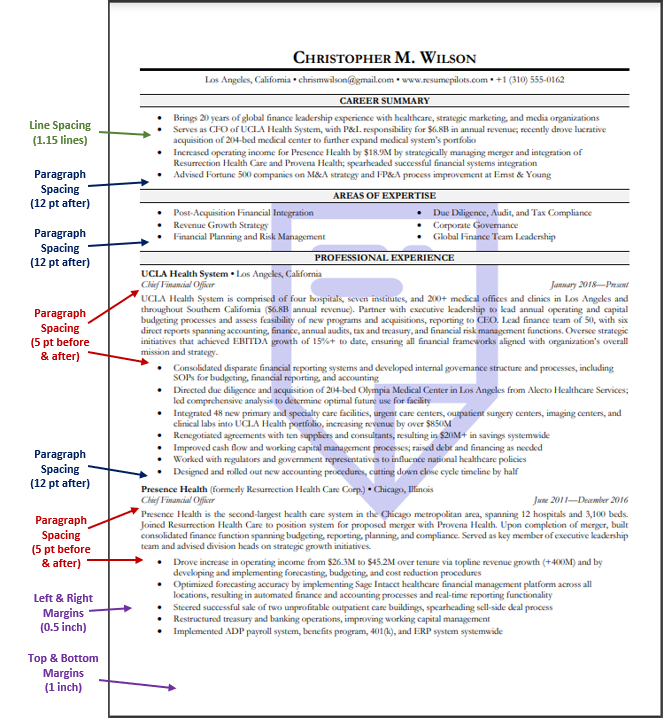
How to Leverage White Space on a Resume
White Space Makes Your Resume Much Easier to Read
When crafting your resume, leverage the white space you have available to give your content “breathing room,” making your resume much easier to read. You can optimize white space on your resume by adjusting your margins, spacing, and font size.
In this article, we explain why it’s not a good idea to cram too much text onto your document, addressing the following questions:
- Do I need to fill up most of the white space on my resume?
- How much white space should I have on my resume?
- What does effective resume spacing look like in practice?
- How can I adjust the margins on my resume?
- How can I adjust the line spacing on my resume?
Do I need to fill up most of the white space on my resume?
Absolutely not! White space is not wasted space. By incorporating sufficient spacing into your resume, you will help recruiters quickly skim your document. As a result, they’ll be able to pick up the key information they need to decide whether they would like to invite you for an interview.
Simply put, if you attempt to cram as much information onto your resume as possible by dramatically reducing font size and margins, you make the recruiter’s job a lot harder than it needs to be.
An overly-cluttered document may even keep a recruiter from reading it altogether (and studies show that recruiters already spend just 7.4 seconds reviewing a resume)!
If you are tempted to keep adding more content to your resume, we strongly recommend taking the time to ensure that your document focuses on capturing the key information. You can always speak to non-essential items during an interview.
Start to narrow the scope of your content by learning how to craft achievement-driven bullet points and tailor your resume to your target roles.
How much white space should I have on my resume?
There is no hard rule for how much white space you should have on your resume. We recommend utilizing margins between 0.5” and 1.0”, paragraph spacing of 8 pt -12 pt after each major section, and line spacing of 1.0 or 1.15 within bullet points and body text (single-spaced).
• Margins
Your margins are simply the white space around the borders of the page.
Pay special attention to margins on the left and right sides of the page, as these make the greatest visual impact. In addition, some recruiters and hiring managers who print resumes on paper like to use the margins to take notes.
You can keep your top and bottom margins a bit tighter, if needed.
• Paragraph Spacing
Paragraph spacing refers to the amount of space between each set of bullet points and after the last line of each major section.
Add 8 pt – 12 pt of spacing between each major section of your resume, as shown below.
• Line Spacing
Line spacing refers to the amount of vertical space between lines of text in a paragraph. We recommend keeping line spacing on your resume at 1.0 to 1.15.
Because you have limited space to work with, you do not need to make your resume double-spaced.
What does effective resume spacing look like?
Effective resume spacing adds skim value to your document, giving the content “breathing room” and making it easier to read. While a cluttered or unevenly spaced resume will convey chaos and disorganization, a well-formatted, clean document will make a positive impression on recruiters.
The resume below provides an example of how you can use spacing to enhance your resume's readability.

Keep in mind that while some white space is desirable, it is possible to have too much as well!
In addition, be sure that each page of your resume is completely filled. A resume that is 1.5 pages long, for example, will look incomplete.
How can I adjust the margins on my resume?
To adjust the margins on your resume in Microsoft Word, select Layout > Margins in the top ribbon.
We recommend using the Moderate or Narrow default settings provided. The Normal setting can also work well, but it will give you less room to work with.

You can also see more detailed instructions and a video tutorial on the Microsoft Office website.
How can I adjust the paragraph spacing on my resume?
To adjust the paragraph spacing on your resume in Microsoft Word, select Design > Paragraph Spacing in the top ribbon. In the Spacing section, add 8 pt – 12 pt in the After field, as shown below.

You will use this setting for the following areas:
- After each set of bullet points
- After the last item in each major section (Heading, Work Experience, Education, Relevant Skills, etc.)
Also, be sure to uncheck the “Don’t add space between paragraphs of the same style” button, if needed.
How can I adjust the line spacing on my resume?
To adjust the line spacing on your resume in Microsoft Word, select Design > Paragraph Spacing in the top ribbon. In the Line Spacing section, select Single. Alternatively, you can select Multiple and input a value up to 1.15.

You will use this setting for the following areas:
- Within individual paragraphs
- To separate consecutive bullet points
In Summary
By following the guidelines provided, you will ensure you are effectively using the white space on your resume.
Additional Reading
To find out more, visit our website www.resumepilots.com. If you have any further questions, you can either book a consultation call with one of our team, or get in touch via email on team@resumepilots.com

